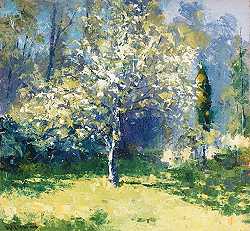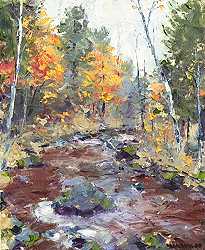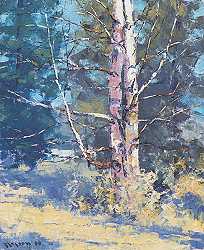"I've always considered myself an outdoor type," Lansing, Michigan artist Tom Nelson says, walking out to his studio/workshop building, located at some distance from the house, "and I suppose that comes from growing up in the country. My Grandparents bought this land in 1925, but it ceased to be a working farm by the time I came along and spent my childhood here. I still live here, even though I've traveled and lived elsewhere in the past, but now it's essentially my place."
Nelson is tall with a medium build. For working, he's usually found in jeans and a T-shirt, adding a sweatshirt for colder weather. We walk into his workshop/studio, an old building that served as a barn in the old days, when the property was a working farm. "It's the original website," he jokes, pointing to spider webs on the ceiling, and adds, "I don't care too much about appearances. It definitely has that 'lived-in' look." There is a stack of firewood along one wall, which feeds a woodstove to heat the workspace. "I have 20 acres covered with trees. Cutting firewood is my exercise, even though it takes time away from art."
There is evidence of diverse activity in the rather small space, all of it directed toward producing art. The artist admits to being a do-it-yourself addict. "I learned to work with my hands at an early age," he says. "So it was a natural thing for me to start making art supplies for myself, mainly as a way to save money. It takes time away from my artwork, but I can usually make better quality than I can buy at a reasonable price." He stretches and primes raw canvas, and his woodworking experience led him into making stretcher bars for canvas. Earlier in his career he did almost all his own framing. "I'd spend as much as 3 or 4 times building a frame by hand than I'd spend on the painting," he says, "but now I can't take the time for it, except very occasionally. I usually have to buy the frame." Even though this focus has changed, framing remains an important consideration. "I'm certain that a good presentation can help your work stand out in a crowded field", he adds.
Pasted along one wall are quotations Nelson has found meaningful to his work. He says they help him over the rough spots. One reads simply, "Failure can't handle persistence." Another, from Vincent Van Gogh, reads, "If you hear a voice within you saying 'I am not a painter', then by all means paint, ... and that voice will be silenced, but only by working." He says, "From an early age, Van Gogh was an inspiration to me." The famous Dutch artist still plays an important role for Nelson in how he approaches his art. He explains, "Like him, I'm essentially self taught, though I've had a few classes and workshops. What really attracts me to Van Gogh is his emotional intensity. I've barely begun to reach that level in my own work. I've formed an even greater respect for him now, realizing how difficult it is to put that intensity on canvas."
Nelson also admires Van Gogh for his work ethic. "Vincent really worked. He was able to cut loose from everything and devote almost all his efforts to producing art. Although the events and circumstances of his life were tragic, he still had a good working arrangement that allowed him free rein to create." Nelson adds, "But he lived in a time when most art materials were very cheap. He could get by on very little. It's different now." Nelson admits to a lot of frustration in scheduling his time. He says, "Like most artists, I don't have enough time to paint. I can't even begin to approach Van Gogh's level of output."

|
"I came to art by a rather circuitous route," he relates. "Like many artists, I drew and painted as a child, but it was spotty, an on-again/off-again affair. But once I won an Honorable Mention in a local Youth Talent show," he remembers of those early years. In Middle and High School he concentrated on a latent interest in science. He says, "I still have an interest in physics and astronomy." In college, an impulse to travel led to his majoring in Zoology at Michigan State University. Of his college years he says, "I quit school a number of times to participate in expeditions to Latin America. I wanted to see far-away places off the beaten track that tourists seldom see." In college, he picked up the thread of his art once again, "mainly to handle the pressure. But I worked in complete isolation back then," he recalls.
After College, his career in Zoology led him to join the Peace Corps, in Paraguay, South America. During that time, he lost contact with art once again. "I spent almost 3 years there, and near the end I realized that I didn't want to spend my life tramping around jungles doing field work," he says, "even though I'd probably jump at the chance to do another field trip, if I could find some way to suspend time for a while. But I'd never want to spend time away from painting with the clock still running."
Returning to the U.S., he realized his life had no anchor, since the career he began in college was now behind him. "It was a very stressful time. I'd wake up nights in a cold sweat," he relates, "but I slowly began to rebuild my life." The next 10 years saw him focusing on various pursuits, mainly cabinet and furniture making, as well as computer programming and technical writing. "I call those my lost years," he says with a twinge of regret. "I wish I'd been doing art then, but it still hadn't found me. But those experiences relate at least indirectly to what I'm doing now," he adds.
His life changed yet again when his parents gave him an easel for Christmas in 1990. "My mother kept encouraging me to get back into art. I'd been slowly gravitating again towards art previous to that date, but getting the easel was a catalyst that clinched the deal for me. Since then, I've never looked back. Art gave me the anchor I'd been looking for," he remembers. "I finally realized my emotional response to the world, to landscape in particular, was the common thread running through my life," he explains, adding, "I found that I needed to put that on canvas."

|
He soon realized, however, that his artistic vision far outstripped his technical ability. "I knew that my earlier experience in art was woefully inadequate for the task I had before me," he relates. "I remember taking some early work into a local gallery owner for his opinion. One was a painting of a road bordered by trees, and he told me it looked more like a bowling alley. I still have those 2 paintings and I look at them every few years. Seeing them now makes my toes curl up in embarrassment--backwards," he quips.
Although he majored in Zoology in college, Nelson says that this never led him into wildlife art. "I was always more interested in landscape," he recalls, adding, "I was exposed to impressionism early in life and that has never really left me, but I've since become interested in other approaches." Even though impressionism was his first focus, he now avoids all stylistic labels to describe his work. "I feel labels tend to keep me in a box, artistically speaking. I want to be free to try other avenues," he says.
Instead of seeing his work through the lens of an -ism label, he wants it to reflect a basic interaction with his world on an emotional level. "I'd like the work to show a personal inner truth, rather than a search for 'new art' and cutting-edge innovation as ends in themselves", he says. Among his friends and acquaintances he counts "... several current and former members of the Art Department at Michigan State University. I admire them and enjoy looking at their work, but their approach to art is generally too sterile and intellectual for me, too divorced from what I see as our shared experience of the world. But, there are notable exceptions." He adds, "in return, I have to put up with their rather bemused opinion of my work as being too sentimental, but I don't reject this opinion at all, it's just another part of the mix that shapes my work." Pausing briefly in thought, he continues, "I definitely don't want to merely repeat what was done before. It's just that I don't necessarily see contemporary/conceptual styles as the only way to do this."
The artist's early exposure to impressionism influences his working techniques. "Like the impressionists, I'm essentially an outdoor painter. Even though I do a fair amount of work in the studio, it's always influenced by what I do onsite," he says. "I never painted outdoors as a kid. I was too shy to let people see what I was doing," he recalls, "so I painted from photographs back then." Now he says he's surmounted most of that fear. "I'm not a natural exhibitionist, but now it's water off a duck's back," he laughs, adding "I can sometimes get energized by interacting with passersby."

|
Soon after beginning to paint seriously, he started working outdoors. "Photographs are a great learning tool. You can concentrate on the basics of landscape painting without the distractions of working on site. But there's always so much that a camera can't capture," he says. He feels that restricting yourself to just photographs eventually becomes a barrier, "... like taking a shower with a raincoat on," he quips. To work successfully from a photo, he says, "you need a good deal of outdoor experience. I really feel that in painting outdoors you use all five senses, instead of just your sense of sight. It comes through subliminally in the result." Nevertheless he realizes that good landscape work can be done in the studio, even from photographs, although the result differs significantly from outdoor work. "Painting is still a visual art, not a performance. In the end, the result is all that really matters," he says.
Nelson sits down and leans back with his legs outstretched. "I like to paint the big canvas outdoors, rather than work from sketches in the studio," he continues, "and if you can pull it off, it's the best way to get a spontaneous result." He adds that almost all his work is done now, "... with palette knives. I like the strong dimensional quality they give to the work," he says, "but using a palette knife was a steep learning curve for me. It's a difficult instrument, and I'm not quite there, yet."
[To be continued ...]